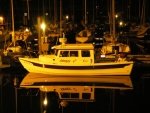Unfortunately the guest chargers are not "smart chargers". A smart charger will sample the batteries' resting state voltage, and only turn on if there is a low battery (Less than 12.6 volts for instance). Ideally one would run the guest type of charger after they are through with the boat, (outboards generally don't keep the charge up to 100%). Then the battery would be turned off.
Ideally a battery charger should come only a few hours a day. One way to affect this is to use a timer on the power input into the boat. (Or buy a smart charger--which are for the most part more expensive.). This may be the best course if you are leaving the boat where it may get water in the cockpit and the battery must be constantly maintained to be sure that the bilge pump is suppled with adequate 12 volt power.
If there are no parasitic drains (such as a radio, voltage charge relay or GPS memory), then the battery should not loose it charge except thru a minimal natural attrition of about 4% of charge a week. For example my battery on the Caracal Cat is turned off between uses, and even after several months, the battery is at a state to start the outboard easily. Generally I'll put a charger on one day a month.
AGM batteries have a lower self discharge rate of 1 to 2% a month, and the LI batteries are even lower than that.
I like to measure the state of charge with a Victron 702 or 712 meter. However when I was experimenting with a cheaper set up to use liFePO4 batteries in a SUV or truck for a cross country trip to power a chest freezer, I found this
Battery monitor for about $42/. There cheaper ones out there, but I have not tried them (some require a manual reset and are fine for one experiment, but not for continuous use.)
Also Victron has a "smart Shunt" which is considerably less than the 712 monitor. This relies on a smart phone to read the information of state of charge. amps in and out, and voltage.
These monitors tell you not only the voltage, but the state of charge, amps in and out etc.

